HI5002 Finance for Business: Woolworths Ltd Analysis Report
VerifiedAdded on 2023/01/11
|15
|1098
|56
Report
AI Summary
This finance report provides a comprehensive analysis of Woolworths Ltd's financial performance. The report begins with an introduction to financing and a description of Woolworths, a major Australian supermarket chain. It then delves into the calculation and analysis of Woolworths' performance using profitability, operational, and liquidity ratios from 2017 to 2019. Further analysis includes cash management, sensitivity analysis, and an examination of systematic and unsystematic risks. The report also covers the dividend payout ratio and concludes with recommendations for financial management and a conclusion summarizing the key findings. The report also includes references to relevant financial literature.

FINANCE
FOR
BUSINESS
FOR
BUSINESS
Paraphrase This Document
Need a fresh take? Get an instant paraphrase of this document with our AI Paraphraser
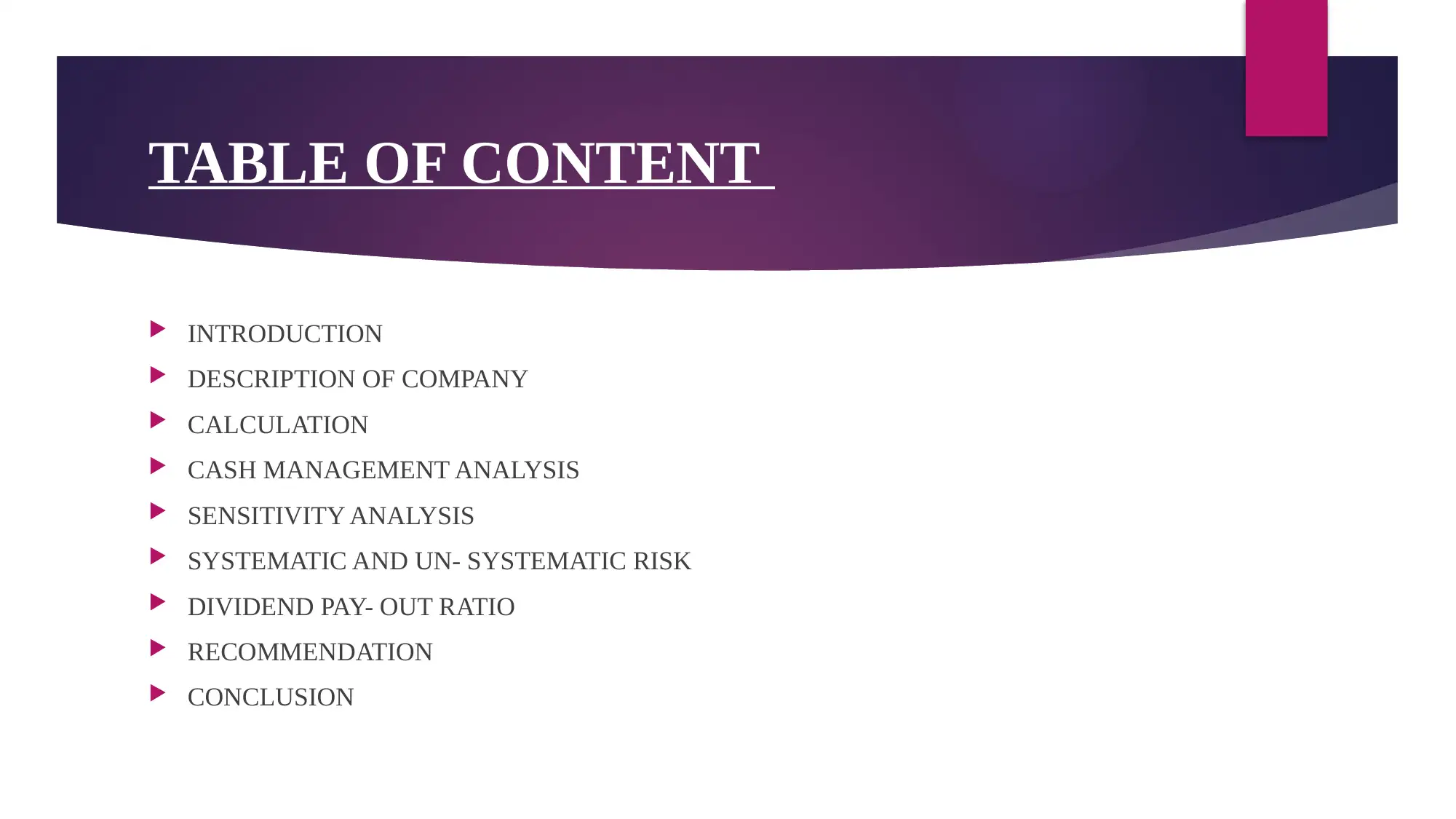
TABLE OF CONTENT
INTRODUCTION
DESCRIPTION OF COMPANY
CALCULATION
CASH MANAGEMENT ANALYSIS
SENSITIVITY ANALYSIS
SYSTEMATIC AND UN- SYSTEMATIC RISK
DIVIDEND PAY- OUT RATIO
RECOMMENDATION
CONCLUSION
INTRODUCTION
DESCRIPTION OF COMPANY
CALCULATION
CASH MANAGEMENT ANALYSIS
SENSITIVITY ANALYSIS
SYSTEMATIC AND UN- SYSTEMATIC RISK
DIVIDEND PAY- OUT RATIO
RECOMMENDATION
CONCLUSION
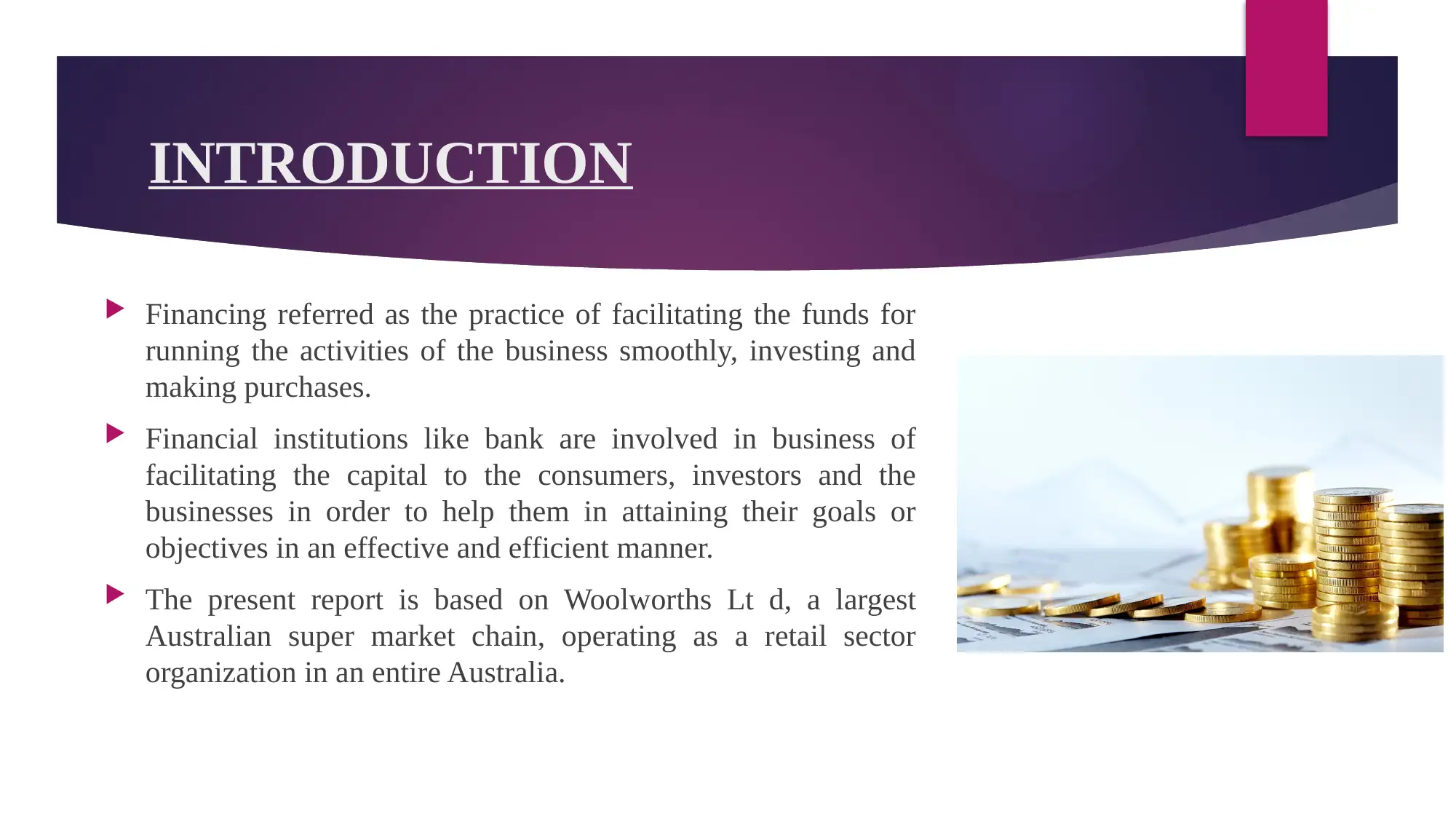
INTRODUCTION
Financing referred as the practice of facilitating the funds for
running the activities of the business smoothly, investing and
making purchases.
Financial institutions like bank are involved in business of
facilitating the capital to the consumers, investors and the
businesses in order to help them in attaining their goals or
objectives in an effective and efficient manner.
The present report is based on Woolworths Lt d, a largest
Australian super market chain, operating as a retail sector
organization in an entire Australia.
Financing referred as the practice of facilitating the funds for
running the activities of the business smoothly, investing and
making purchases.
Financial institutions like bank are involved in business of
facilitating the capital to the consumers, investors and the
businesses in order to help them in attaining their goals or
objectives in an effective and efficient manner.
The present report is based on Woolworths Lt d, a largest
Australian super market chain, operating as a retail sector
organization in an entire Australia.
⊘ This is a preview!⊘
Do you want full access?
Subscribe today to unlock all pages.

Trusted by 1+ million students worldwide
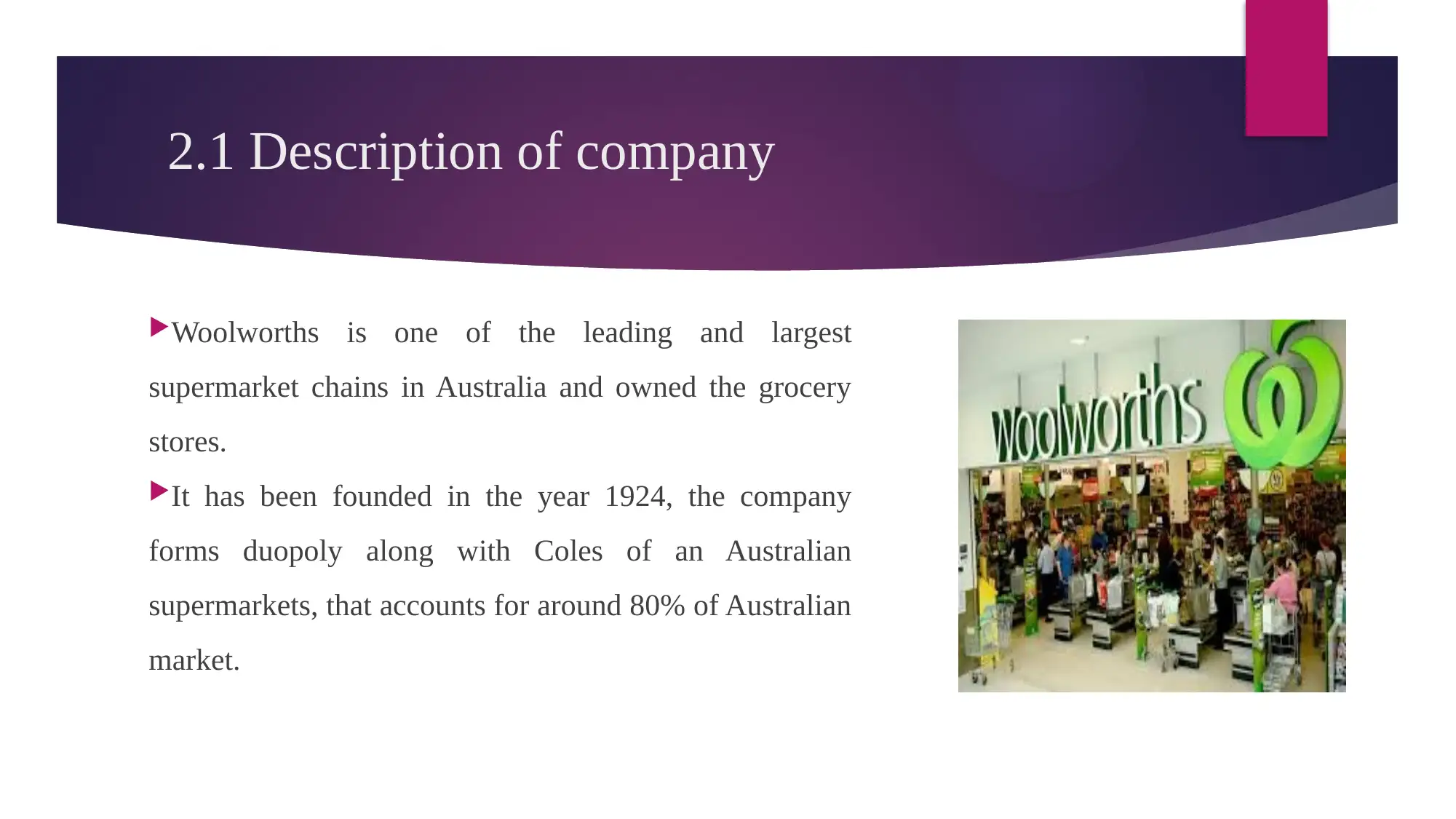
2.1 Description of company
Woolworths is one of the leading and largest
supermarket chains in Australia and owned the grocery
stores.
It has been founded in the year 1924, the company
forms duopoly along with Coles of an Australian
supermarkets, that accounts for around 80% of Australian
market.
Woolworths is one of the leading and largest
supermarket chains in Australia and owned the grocery
stores.
It has been founded in the year 1924, the company
forms duopoly along with Coles of an Australian
supermarkets, that accounts for around 80% of Australian
market.
Paraphrase This Document
Need a fresh take? Get an instant paraphrase of this document with our AI Paraphraser
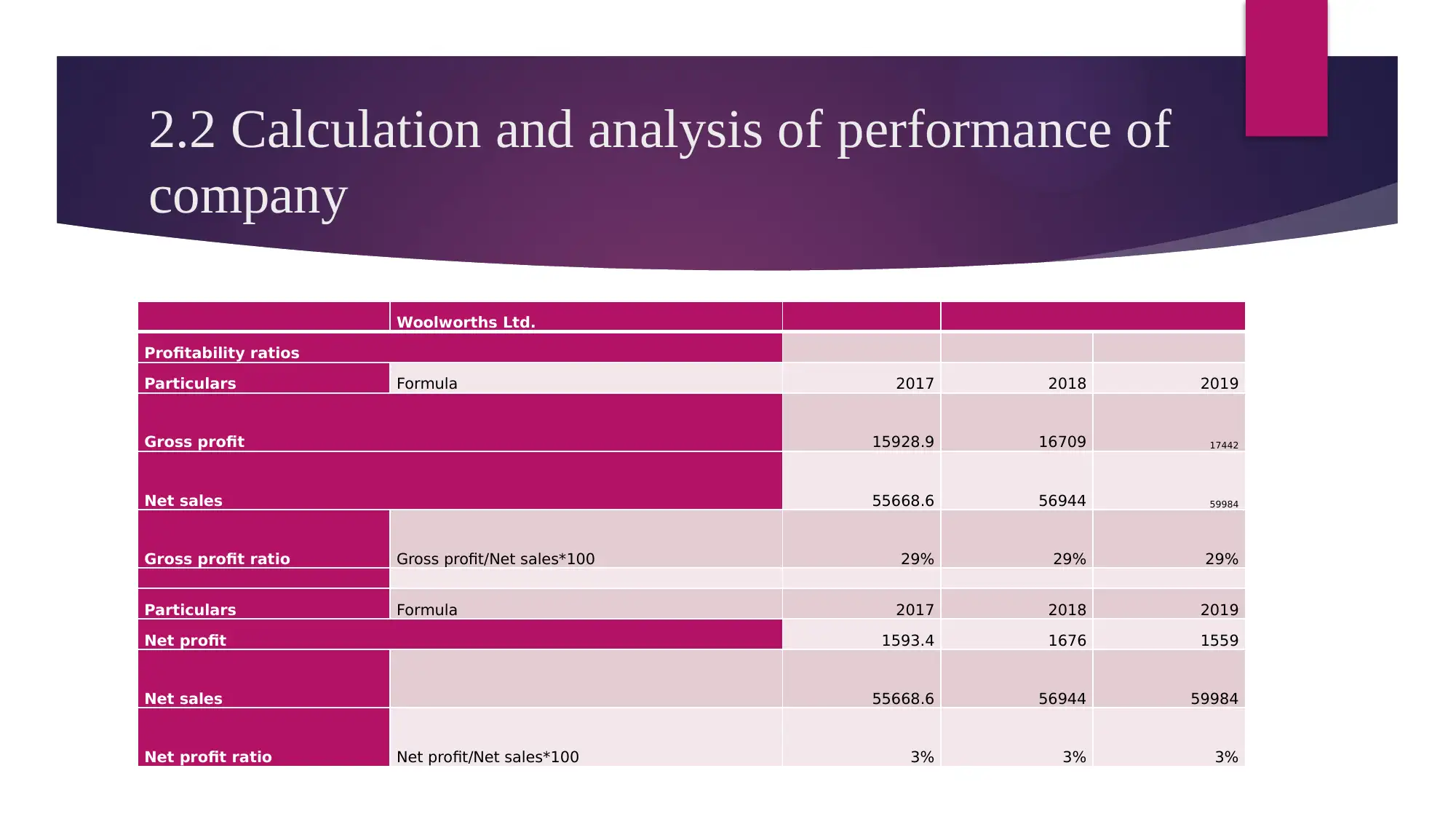
2.2 Calculation and analysis of performance of
company
Woolworths Ltd.
Profitability ratios
Particulars Formula 2017 2018 2019
Gross profit 15928.9 16709 17442
Net sales 55668.6 56944 59984
Gross profit ratio Gross profit/Net sales*100 29% 29% 29%
Particulars Formula 2017 2018 2019
Net profit 1593.4 1676 1559
Net sales 55668.6 56944 59984
Net profit ratio Net profit/Net sales*100 3% 3% 3%
company
Woolworths Ltd.
Profitability ratios
Particulars Formula 2017 2018 2019
Gross profit 15928.9 16709 17442
Net sales 55668.6 56944 59984
Gross profit ratio Gross profit/Net sales*100 29% 29% 29%
Particulars Formula 2017 2018 2019
Net profit 1593.4 1676 1559
Net sales 55668.6 56944 59984
Net profit ratio Net profit/Net sales*100 3% 3% 3%

Operational ratios
Liquidity ratios
Particulars Formula 2017 2018 2019
Current assets 6994.2 7014 6298
Current liabilities 8824.2 9029 8620
Current ratio Current assets/ Current liabilities 0.79 0.78 0.73
Particulars Formula 2017 2018 2019
Current assets 6994.2 7014 6298
Inventory 4080.4 4233 4280
Quick assets Current assets-Inventory 2913.8 2781 2018
Current liabilities 8824.2 9029 8620
Quick ratio Quick assets/Current liabilities 0.33 0.31 0.23
Efficiency ratios
Particulars Formula 2017 2018 2019
Cost of goods sold 39739.7 40235 42542
Inventory 4080.4 4233 4280
Inventory Turnover ratio Cost of goods sold/Inventory 9.74 9.5 9.9
Net sales 55668.6 56944 59984
Average total assets 22915.8 23,391 23491
Asset turnover ratio Net sales/Average inventory 2.43 2.43 2.55
Liquidity ratios
Particulars Formula 2017 2018 2019
Current assets 6994.2 7014 6298
Current liabilities 8824.2 9029 8620
Current ratio Current assets/ Current liabilities 0.79 0.78 0.73
Particulars Formula 2017 2018 2019
Current assets 6994.2 7014 6298
Inventory 4080.4 4233 4280
Quick assets Current assets-Inventory 2913.8 2781 2018
Current liabilities 8824.2 9029 8620
Quick ratio Quick assets/Current liabilities 0.33 0.31 0.23
Efficiency ratios
Particulars Formula 2017 2018 2019
Cost of goods sold 39739.7 40235 42542
Inventory 4080.4 4233 4280
Inventory Turnover ratio Cost of goods sold/Inventory 9.74 9.5 9.9
Net sales 55668.6 56944 59984
Average total assets 22915.8 23,391 23491
Asset turnover ratio Net sales/Average inventory 2.43 2.43 2.55
⊘ This is a preview!⊘
Do you want full access?
Subscribe today to unlock all pages.

Trusted by 1+ million students worldwide

2.3 Cash management analysis
The cash is the most important thing without which
the company cannot run or exist in the highly
competitive market.
This is majorly because of the reason that if the cash
is not proper in the business then the company will
not be able to manage the operations of the company.
Marketable securities are
Common stock
Commercial paper
The cash is the most important thing without which
the company cannot run or exist in the highly
competitive market.
This is majorly because of the reason that if the cash
is not proper in the business then the company will
not be able to manage the operations of the company.
Marketable securities are
Common stock
Commercial paper
Paraphrase This Document
Need a fresh take? Get an instant paraphrase of this document with our AI Paraphraser
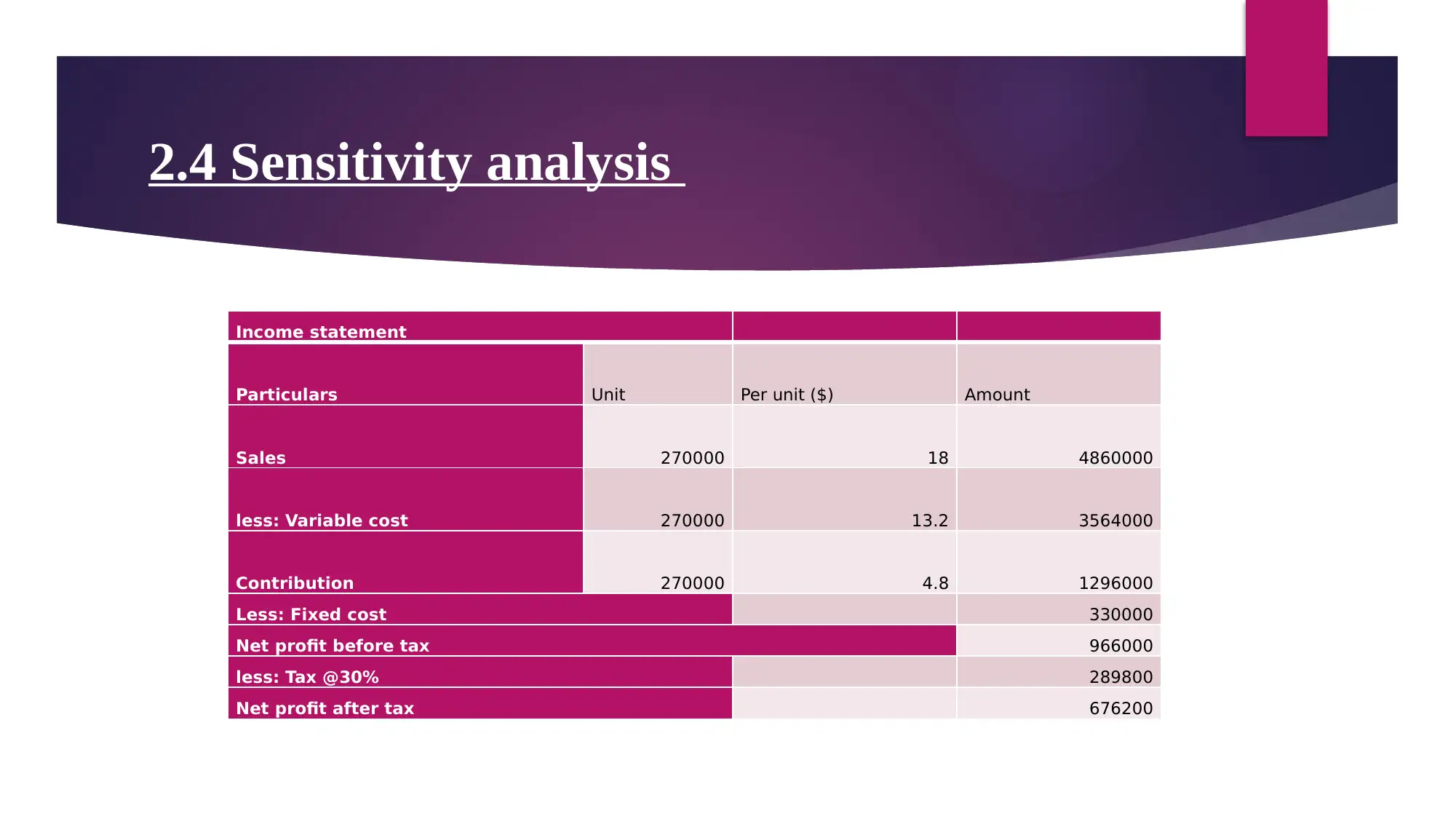
2.4 Sensitivity analysis
Income statement
Particulars Unit Per unit ($) Amount
Sales 270000 18 4860000
less: Variable cost 270000 13.2 3564000
Contribution 270000 4.8 1296000
Less: Fixed cost 330000
Net profit before tax 966000
less: Tax @30% 289800
Net profit after tax 676200
Income statement
Particulars Unit Per unit ($) Amount
Sales 270000 18 4860000
less: Variable cost 270000 13.2 3564000
Contribution 270000 4.8 1296000
Less: Fixed cost 330000
Net profit before tax 966000
less: Tax @30% 289800
Net profit after tax 676200
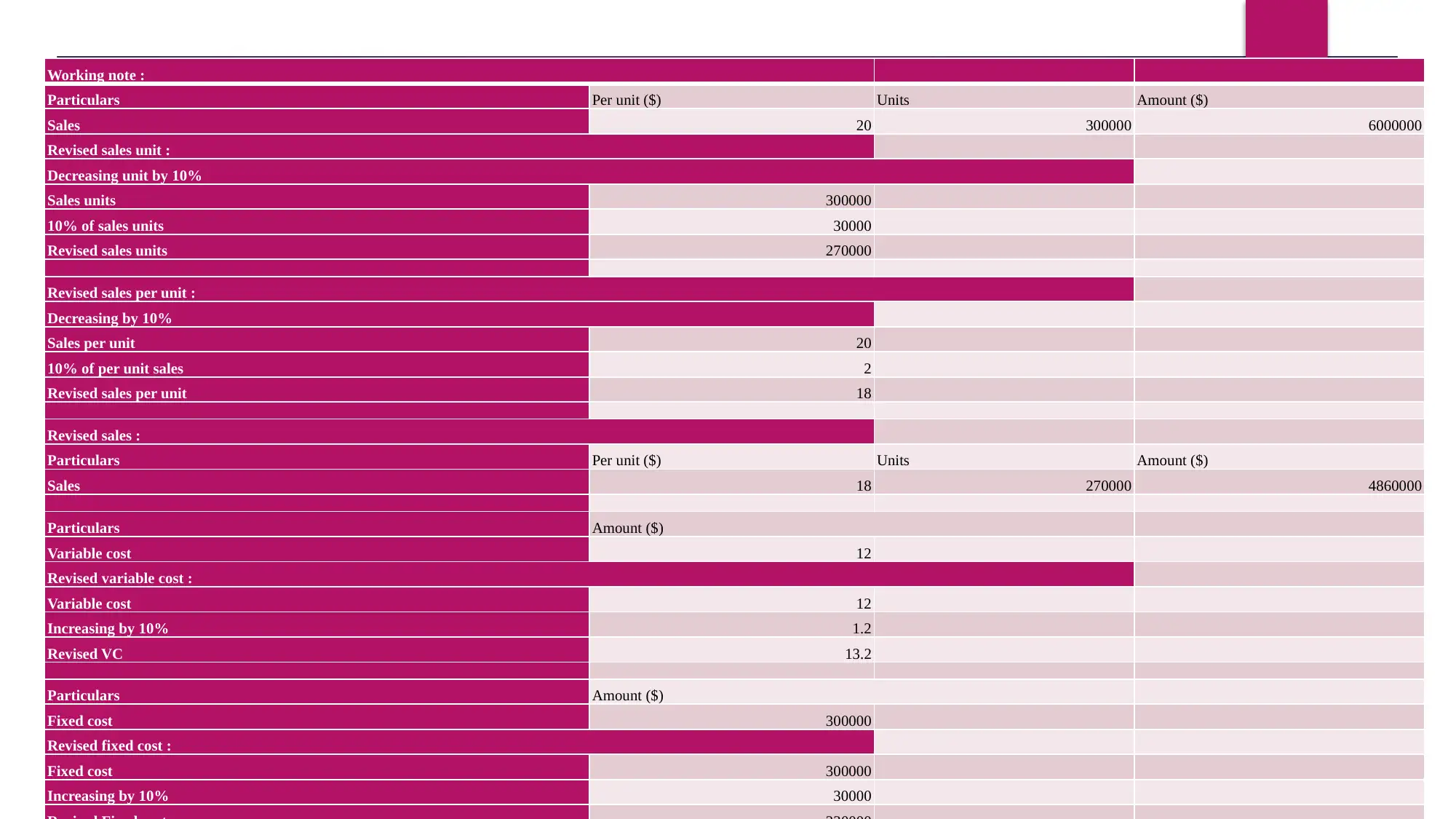
Working note :
Particulars Per unit ($) Units Amount ($)
Sales 20 300000 6000000
Revised sales unit :
Decreasing unit by 10%
Sales units 300000
10% of sales units 30000
Revised sales units 270000
Revised sales per unit :
Decreasing by 10%
Sales per unit 20
10% of per unit sales 2
Revised sales per unit 18
Revised sales :
Particulars Per unit ($) Units Amount ($)
Sales 18 270000 4860000
Particulars Amount ($)
Variable cost 12
Revised variable cost :
Variable cost 12
Increasing by 10% 1.2
Revised VC 13.2
Particulars Amount ($)
Fixed cost 300000
Revised fixed cost :
Fixed cost 300000
Increasing by 10% 30000
Particulars Per unit ($) Units Amount ($)
Sales 20 300000 6000000
Revised sales unit :
Decreasing unit by 10%
Sales units 300000
10% of sales units 30000
Revised sales units 270000
Revised sales per unit :
Decreasing by 10%
Sales per unit 20
10% of per unit sales 2
Revised sales per unit 18
Revised sales :
Particulars Per unit ($) Units Amount ($)
Sales 18 270000 4860000
Particulars Amount ($)
Variable cost 12
Revised variable cost :
Variable cost 12
Increasing by 10% 1.2
Revised VC 13.2
Particulars Amount ($)
Fixed cost 300000
Revised fixed cost :
Fixed cost 300000
Increasing by 10% 30000
⊘ This is a preview!⊘
Do you want full access?
Subscribe today to unlock all pages.

Trusted by 1+ million students worldwide

2.5 Systematic and un- systematic risk
The risk is the uncertain event which may occur within the future and this may impact the
performance of the company in negative manner.
Systematic risk
• Change in law
• Interest rate hike
Un- systematic risk
• Strike by employees
• Financial risk
The risk is the uncertain event which may occur within the future and this may impact the
performance of the company in negative manner.
Systematic risk
• Change in law
• Interest rate hike
Un- systematic risk
• Strike by employees
• Financial risk
Paraphrase This Document
Need a fresh take? Get an instant paraphrase of this document with our AI Paraphraser

2.6 Dividend pay- out ratio and policy of
dividend
The dividend pay- out ratio is the type of ratio which is helpful for the company in
calculating the total amount of the dividend which is payable to the shareholders in
relation with the net income earned by the company.
This is also referred to as the percentage of earning paid to the shareholders in form of the
dividend over their amount which is being invested.
The major reason behind the name pay- out ratio is because of the fact that this ratio
suggests the amount which is being paid out to the shareholders against the amount which
they have invested within the business.
Since past 3 years the dividend being provided by the company is very high is on
increasing trend only.
dividend
The dividend pay- out ratio is the type of ratio which is helpful for the company in
calculating the total amount of the dividend which is payable to the shareholders in
relation with the net income earned by the company.
This is also referred to as the percentage of earning paid to the shareholders in form of the
dividend over their amount which is being invested.
The major reason behind the name pay- out ratio is because of the fact that this ratio
suggests the amount which is being paid out to the shareholders against the amount which
they have invested within the business.
Since past 3 years the dividend being provided by the company is very high is on
increasing trend only.
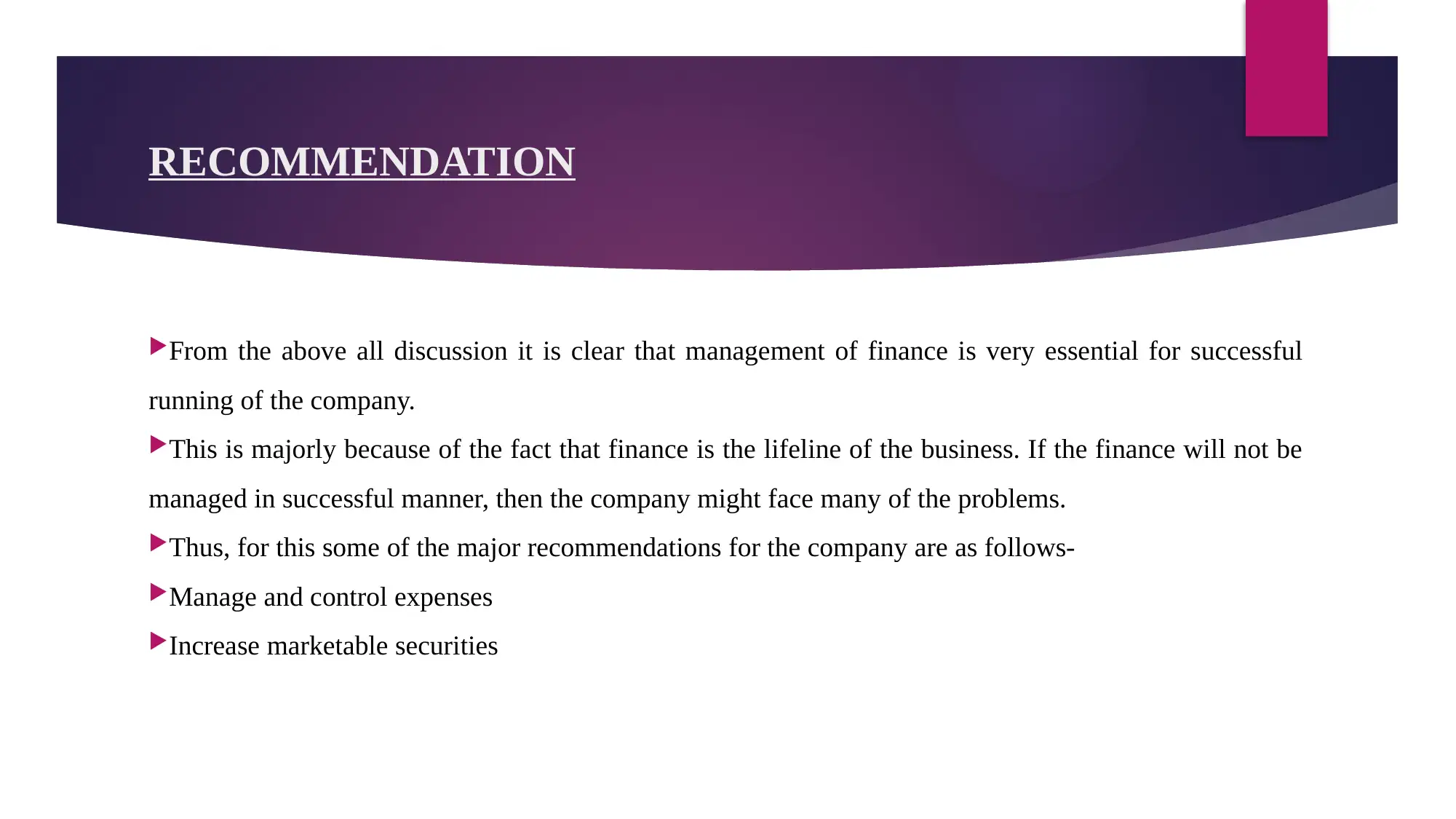
RECOMMENDATION
From the above all discussion it is clear that management of finance is very essential for successful
running of the company.
This is majorly because of the fact that finance is the lifeline of the business. If the finance will not be
managed in successful manner, then the company might face many of the problems.
Thus, for this some of the major recommendations for the company are as follows-
Manage and control expenses
Increase marketable securities
From the above all discussion it is clear that management of finance is very essential for successful
running of the company.
This is majorly because of the fact that finance is the lifeline of the business. If the finance will not be
managed in successful manner, then the company might face many of the problems.
Thus, for this some of the major recommendations for the company are as follows-
Manage and control expenses
Increase marketable securities
⊘ This is a preview!⊘
Do you want full access?
Subscribe today to unlock all pages.

Trusted by 1+ million students worldwide
1 out of 15
Related Documents
Your All-in-One AI-Powered Toolkit for Academic Success.
+13062052269
info@desklib.com
Available 24*7 on WhatsApp / Email
![[object Object]](/_next/static/media/star-bottom.7253800d.svg)
Unlock your academic potential
Copyright © 2020–2025 A2Z Services. All Rights Reserved. Developed and managed by ZUCOL.





